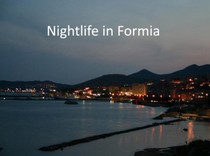Itineraries - Linea Blu
Main menu:
Itineraries
What to see in Formia Photogallery
The tomb of Cicerone is a monumental mausoleum of the Imperial age. Located at the entrance of Formia, coming from Itri, near the area where the House of Cicero, the 24-metre high stone column with rings, reasonably be expected to actually be the funeral monument dedicated to a famous man. It is known that Cicero's remains lie in Formia but in Rome, as it is known that in the Tomb on the hill near the tomb of Cicero, lie the remains of Tulliola, daughter of Cicero died in childbirth. To visit the mausoleum, you must contact the National Archaeological Museum of Formia.
Bed and breakfast distance 1.5 Km
National Archaeological Museum of Formia the Museum recently built (1997), artistic sculptures, highly prevalent, dating in large part between the 1st century BC. BC and the first century. a.d., the period of greatest flowering of the city. It is the company's statues erected to eminent members from formia-patrons, magistrates-but also to characters of the imperial family (you can recognize an image of Gaius Caesar, grandson of Augustus) found mainly in the area of the ancient City Forum. Among other sculptures, after the discovery at the same site in the 1920s, were transferred to the Archaeological Museum of Naples, have returned recently to Formia: three heroic portrait head, virile in statues nudity a statue two female panneggiate, sacrificing a veiled head of youth and a portrait of elderly woman. There are also depictions of gods and mythological subjects (Ares, a valuable Leda and the Swan, season, Gaminede, etc.) intended to decorate the luxurious Roman villas Maritimes that arose several on coast. Exposes also architectural elements and exhibits related to funerary sphere. There is also a significant sampling of the major Roman coins, which can be dated between the Republican and the late Empire.
Bed and breakfast distance 950 Meters
The Cisternone, or the underground Basilica, is a large reservoir formed by four aisles from the 1st century b.c. and represents a fundamental testimony of Roman hydraulic engineering. Recently restored and open to the public, is located on the top of the village of Castellone.La (the second largest in Italy) was fed by the headwaters of the hilly area of Santa Maria la Noce to ensure the water supply of the city. Visit, an extraordinary sensory experience of space and time, a wonderful find of an ancient world.
Bed and breakfast distance 900 Mt
The cryptoporticoes Villa Comunale "Umberto I" covers the remains of a 2nd century BC – maritime residence which remains the Cryptoporticoes, consisting of a single Central Hall and a series of stanze in masonry with a round arch, the quantity of wine amphorae found nearby it is assumed that they were used as warehouses associated with the fishpond (visible at low tide in the afternoon) which served as a fish hatchery.
Bed and breakfast distance 1 Km
The Church of Saint Erasmus is the time of Constantine, was built on a pagan Christian cemetery where he was buried the Saint of Antioch patron of Formia. Features three naves and preserve a painted 18th century anonymous, a slab burial chamber of the Dukes of Marzano of 1698 and the altar containing a wooden statue of the Saint. In the basement are the remains of a Roman necropolis of I-IV century martoriale Tomb from the 4th century, the primitive Cathedral of the fifth century, the tomb of the 7th century, the Benedictines of the eleventh century, 16th century structures in Constantinople and the burial chamber of the 18th century.
Bed and breakfast distance 800 Mt
The Tower of Castellone is located in the village of Carlton and is one of the twelve towers of the walls to have survived. The Tower consists of three different layers: a polygonal romana, a strengthening of Republican age and finally the Caetani Tower.
The other Tower has survived is the port of the Spaniards or clock tower, due to the presence of an eighteenth-century majolica clock, which was the entrance to the village of Carlton.
Bed and breakfast distance 850 Mt
The Borgo Castellone presents a structure is medieval Roman. Built at the behest of Onorato I Caetani and raised on the ruins of an ancient Roman arce, was born to counter the invasions by sea. Due to differences in height, boasted an excellent lookout position and rapid communication to the vicinity of the Via Appia. The entrance was on the South, through the "gate of the Spaniards" and the perimeter was protected by walls with towers.
Bed and breakfast distance 900 Mt
The Borgo Mola, is a quaint seaside and shopping district built on Roman ruins, with the great medieval tower that bears his name. The entrance to the village is characterized by a portal that proposes the architectural taste of Roman triumphal arches and you can also admire the few but significant remains of the Roman aqueduct.
Bed and breakfast distance 2 Km
Festivals and traditions
Feast of Saint Erasmus 2 June
Patron of Formia is Sant'Erasmo and is celebrated on June 2. In life he was persecuted and it is said that he was wounded in the alleys of the neighborhood Carlson. Subjected to horrific torture, is considered the patron saint of sailors. Sailors aboard venerate him with Elmo's name because legend has it that intent in his sermon during a thunderstorm, the Saint did not let himself be distracted even by lightning fell nearby. The statue with the relics is carried in procession through the streets of the town in a festive atmosphere followed by numerous initiatives and shows with Fireworks at the close of the festivities.
Feast of Saint John the Baptist on June 24
In the neighborhood, "Mola", on 24 June is celebrated the other patron of Formia.
The rite, quaint and charming, predicts that in the morning the Saint, patron saint of fishermen, is carried in procession through the streets of the city to the port, where a fisherman reading a prayer. In order to bless the sea, the statue is loaded on a barge followed by all the other boats. After the blessing, the Saint is reported to church and salutes the city: before returning the statue is given to the people and is hoisted to the sky twice. All this is accompanied by fireworks and the festive atmosphere continues throughout the day up to traditional evening shows!
Summer from Formia (August) featuring theatre, music, dance and cultural events throughout August with many guests of national importance.
The Surroundings
The Cima del Redentore (1252 m) is situated on the South shoulder of Mount Altino, just above of the Hermitage of San Michele (1220 m). Here, you will find a little chapel on whose roof is placed the bronze statue of the Redeemer. From the top you can see one of the most beautiful panorama of the entire Apennine mountains: the coast of Formia, Gaeta and Dig up from the mouth of the Garigliano, at monte Massico, Mount Vesuvius, mount Faito, up to Ischia and Capri.
Bed and breakfast distance 8 Km
The Montagna Spaccata Gaeta. Ancient legends of pirates are mixed with stories of Saints and everything is wrapped in a palpable aura of mystery in contrast with the bright colours of the sky and the sea. Trip to the age-old devotion to the shrine of the Holy Trinity, also known as sanctuary of split mountain. Images of quiet natural surroundings of exceptional beauty. Legend has it that the mountain will split the passing of Jesus Christ annually hosts many visitors from all over the world.
Bed and breakfast distance 7 Km
Parco Regionale Monti Aurunci. Mountain range of southern Latium, situated between the Liri-Garigliano, the Tyrrhenian Sea and the contiguous massif of Monti Ausoni. The Park affects the municipalities of Ausonia, Campodimele, Itri, Fondi, Formia, Lenola, Esperia, Pico, Pontecorvo, Spigno Saturnia, between the provinces of Latina and Frosinone. Is it possible to make long excursions to trekking and riding in full respect of nature for visitors interested.
Angevin-Aragonese castle Gaeta. It is not easy to go back to when it was built the castle of Gaeta. It was probably erected in the 6th century the Goths during the war or in the 7th century. The structure that we admire today, about 14,100 m ², is known as the Angevin-aragonese Castle because it consists of two connected buildings made of two different historical moments, one lower said Angevin, built during the French domination of the Angevins, and one higher up said "aragonese", built by Emperor Charles V, along with all other military defense works that went to strengthen the fortress of Gaeta. Only at certain times of the year can be visited inside.
Bed and breakfast distance 8 km
Sperlonga village perched on a rocky spur, the final part of the Aurunci, which juts out into the Tyrrhenian Sea into the Mount of San Magno.Il the surrounding area is mostly flat. Fine golden sandy beaches alternate with various rock outcroppings that are thrown into the sea, forming wonderful coves often accessible only by boat. These formations are present South of town, towards the promontory to Gaeta. Is part of the circuit of the most beautiful villages in Italy.
Bed and breakfast distance 22 km
Pontine Islands are an archipelago of six large islands in the Tyrrhenian Sea, off the coast of the Gulf of Gaeta. The largest island is Ponza, but the archipelago also includes the islands of Zannone, Ventotene, Palmarola, Gavi and Santo Stefano. The last two are not seeing as they are private islands, with no beaches and practically uninhabited. Instead, Zannone, is inhabited only in summer and is part of the Circeo National Park because of its naturalistic relevance. Are connected with the port of Formia with daily departures of hydrofoils and ferries.
Bed and breakfast 2:30 distance 1:20 Hydrofoil Ferry
Abbey of Montecassino Cassino is one of the most famous monasteries in the world.
Saint Benedict in 529 chose this mountain to build a monastery and his religious order through prayer and work. Every day thousands of pilgrims and visitors from all over the world they cross this threshold, cut across noiselessly the cloisters and then go up the grand staircase to the Basilica, the tomb of Saint Benedict and Scholastica. Below there is the crypt, to explore with beautiful golden mosaics. But it is in the Museum at the end visitors can see magnificent paintings, wonderful manuscripts and old books; can trace the history of the Abbey (even through the vicissitudes of World War II) from the beginnings to the present day and understand why Montecassino is known as the "lighthouse of Western civilization".
Bed and breakfast distance 43 Km
The "Riviera of Ulysses" so called offers an impressive and wide choice of itineraries to be discovered and things to live, to make your stay as pleasant as possible we have mentioned some for more information do not hesitate to contact us, or follow this link.
Follow the links to get to the places that interest you as a useful tool to plan and enjoy your stay with us.









